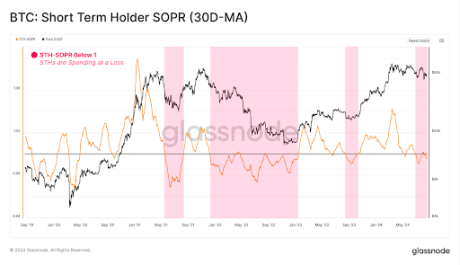Bitcoin crashed below $50,000 on August 5 in a sudden dip that saw many positions liquidated within the crypto market. This sudden dip, which cascaded into other cryptocurrencies, took the market by surprise. As such, Bitcoin fell to its lowest price in six months, and lots of other altcoins followed suit. Although Bitcoin has since recovered by 20% and now finds itself trading around slightly below $60,000, many short-term holders are still sitting in unrealized losses.
A recent report from Glassnode, a number one blockchain evaluation firm, sheds light on the aspects contributing to this abrupt market downturn. The report suggests that the crash was largely driven by an overreaction from short-term holders, who were quick to liquidate their positions within the face of the initial decline.
Bitcoin Short-Term Holders Quick To Capitulate
Short-term holders are typically defined as those investors who hold onto their cryptocurrency assets for a comparatively transient period, often around a month or so. As such, they’re quickly liable to capitulating during times of price corrections. This trend has particularly been evident in the most recent Bitcoin price correction/consolidation, which has lasted far longer than many investors expected.
Related Reading
In line with Glassnode’s most up-to-date on-chain report, a key metric referred to as the STH-MVRV (Market Value to Realized Value) ratio has fallen below the critical equilibrium value of 1.0. When the STH-MVRV ratio dips below 1.0, it suggests that, on average, latest investors are holding their Bitcoin at a loss somewhat than a profit. These unrealized losses, sometimes called paper losses, occur when the market value of an asset is lower than the worth at which it was acquired, however the asset has not yet been sold. That is different from realized losses, which arise from accomplished trades.
Source: Glassnode
While periods of transient unrealized loss are common during bull markets, they have an inclination to place selling pressure on the worth of Bitcoin. It is because sustained periods of STH-MVRV trading below 1.0 often result in the next likelihood of panic and capitulation amongst short-term holders. Notably, this phenomenon contributed to the Bitcoin crash earlier within the month.
Related Reading
Moreover, Glassnode’s report reveals this correlation and selling pressure might already be going down, with the STH-SOPR (Spent Output Profit Ratio) also trading below 1.0. The STH-SOPR ratio measures the profitability of spent outputs, indicating whether assets are being sold at a profit or loss. What this essentially means is that many short-term investors are more taking realized losses than profit. This follows the claim that many short-term holders have been overreacting to the worth corrections.
 Source: Glassnode
Source: Glassnode
While short-term holders have carried most of the losses across the recent downturn, long-term holders remain strong. On the time of writing, Bitcoin is trading at $59,540 and is down by 2.15% prior to now 24 hours.
BTC price struggles to interrupt $60,000 | Source: BTCUSD on Tradingview.com
Featured image created with Dall.E, chart from Tradingview.com